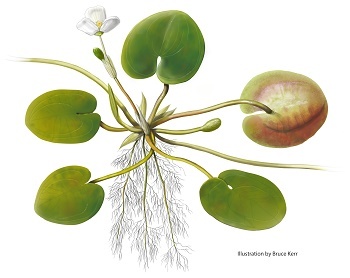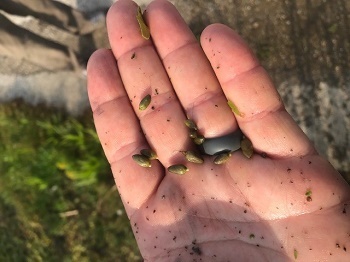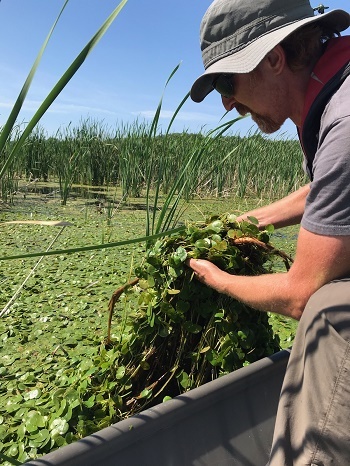|
Aug. 19, 2021
Program contact: Tom Alwin, 517-342-4069
Media contact: EGLE Media Office, EGLE-Assist@Michigan.gov or 517-284-9278
European frog-bit, an invasive aquatic plant, has been found in the lower Lincoln River in Mason County. The Michigan Department of Environment, Great Lakes, and Energy also has confirmed the presence of European frog-bit in several other locations across the state.

“Because aquatic invasive plants like European frog-bit are difficult and costly to control, we are reminding boaters, waterfowl hunters and anglers to remove plants and debris from boats, trailers and gear after each use to prevent the spread of this and other invasive species,” said Joanne Foreman, invasive species communications coordinator with the Michigan Department of Natural Resources.
European frog-bit was first detected in southeast Michigan in 1996 and has since spread along the coastal areas of lakes Erie and Huron up to the eastern Upper Peninsula.
In 2016, the plant, which resembles a miniature water lily with leaves about the size of a quarter, was discovered in Reeds and Fisk lakes in East Grand Rapids. More recently, it was discovered in the Lower Grand River (Ottawa County) and Pentwater Lake (Oceana County) in 2019 and Dansville State Game Area (Ingham County), Waterloo Recreation Area (Jackson and Washtenaw counties) and the Les Cheneaux Islands (Mackinac County) in 2020.
|
The problem
European frog-bit can form dense mats on the surface of slow-moving waters like bayous, backwaters and wetlands. These mats can impede boat traffic and movement of large fish and diving ducks.

Because European frog-bit is free-floating, it can easily spread or be transported to new locations. European frog-bit also produces seed-like structures called turions that may remain dormant for multiple seasons. Activities like boating, waterfowl hunting and fishing can unintentionally help spread the invasive plant because plant parts and turions can attach to boats, trailers and gear.
Many of the bodies of water where European frog-bit is being found are popular destinations for fishing, hunting and water recreation, which means there is a high potential to spread European frog-bit from these locations to other areas of the state.
|
What we’re doing
Michigan's Invasive Species Program staff and partners plan and undertake survey and response efforts. Michigan’s Invasive Species Program is cooperatively implemented by the DNR, EGLE and the Department of Agriculture and Rural Development.

For the newly discovered European frog-bit site in the lower Lincoln River, the North Country Cooperative Invasive Species Management Area is developing a response plan that includes chemical control to prevent further spread while the population is still small and localized.
The Upper Peninsula Resource Conservation and Development Council and all five U.P. CISMAs are working together to survey high-risk areas across the entire U.P. To date, no new infestations have been found outside known infested areas in Chippewa and Mackinac counties.
The Oakland County CISMA is leading a large-scale effort to document European frog-bit distribution across the county and conduct targeted control efforts to reduce further spread.
To address recently detected European frog-bit populations in Ingham and Washtenaw counties, EGLE staff is working with both the Mid-Michigan and the Jackson, Lenawee and Washtenaw CISMAs to contain the invasive plant and reduce the chance of spread to other nearby bodies of water.
|
How you can help
If you think you have seen European frog-bit outside of these known locations, please email EGLE-WRD-AIP@Michigan.gov and provide the location and a photograph.
Additionally, boaters, anglers, and waterfowl hunters are being asked to Clean, Drain and Dry any boats, trailers and other gear prior to use in another body of water to help prevent the spread of European frog-bit and other aquatic invasive species.
-
Clean: Inspect boats, trailers, docks and gear and remove all mud, debris and plant material. Use a hose or power washer when available. Dispose of unwanted material in a trash can.
-
Drain: Remove water from live wells, bait buckets, bilges and other compartments before leaving an access site.
-
Dry: Allow boats and gear to dry for at least five days, if possible, before use in other bodies of water.
For more information about European frog-bit and other invasive species, visit Michigan.gov/Invasives.
Michigan's Invasive Species Program is cooperatively implemented by the Department of Environment, Great Lakes, and Energy, the Department of Natural Resources, and the Department of Agriculture and Rural Development.
Note to editors: The accompanying photos are available for download. Caption information follows.
Illustration: European frog-bit is a free-floating aquatic plant with small (0.5- to 2.5-inch) leaves. Illustration courtesy of Bruce Kerr.
Turions: Tiny, seed-like structures called turions can attach to boats and gear and spread European frog-bit to new locations.
Alwin: EGLE aquatic biologist Tom Alwin removes European frog-bit from a backwater area in Pentwater River State Game Area.
|